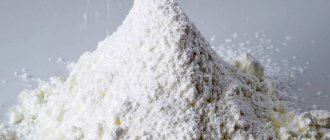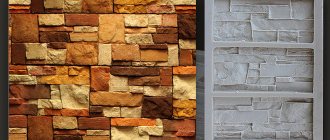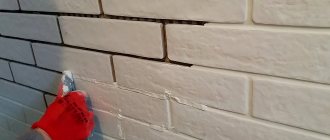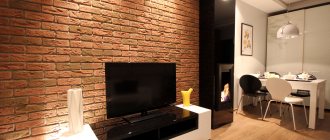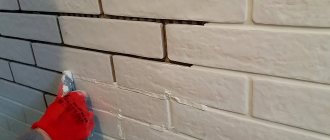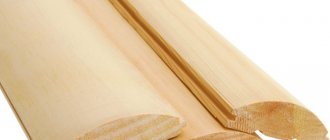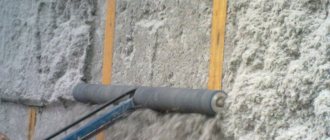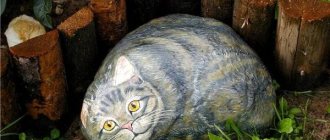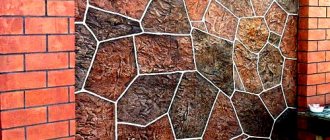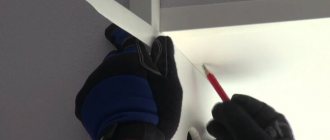Material rating
20 out of 5 price
16 out of 5
practicality
20 out of 5
appearance
20 out of 5
ease of manufacture
20 out of 5
labor intensity when using
20 out of 5
environmental friendliness
final grade
4.8
4.8 out of 5
Gypsum is a sedimentary mineral that occurs naturally as layers of sedimentary rock. These are crystals of white, transparent color, having various shades from yellowish to red. The mineral is formed due to the evaporation of water saturated with calcium.
Definition and main characteristics
Building gypsum is a natural mineral from the sulfate class.
Its chemical formula is CaSO4·2H2O (calcium sulfate hydrate). Since the molecule of the substance contains 2 water atoms, it is also called calcium diacquasulfate. The fine-crystalline structure with a large number of pores is both a positive quality (provides lightness and resistance to high temperatures) and a negative quality (does not provide strength and moisture resistance).
The optimal porosity of the product after hardening is 40-60%. If it is higher, the product becomes less durable and breaks easily. Porosity depends on the amount of water used when mixing the solution.
The specific gravity of the material is 2.6-2.75 g/cm³. Density in a loose state is 800-1100 g/m³, when compacted it can reach 1450 kg/m³.
What does building gypsum look like externally? It is a fairly finely ground powder, usually white or greyish, sometimes with a yellow or pink tint. The smell is very weak and intensifies when water is added.
The liquid solution (dough) is a gray mass with a specific odor. After drying, it acquires a white or light gray color, the surface of the finished product is smooth to the touch.
Gypsum powder
Gypsum mortar
An alternative to traditional plaster in traumatology
Plaster bandage is a modern type of dressing material used by trauma centers for fixing fractures, dislocations and sprains, as well as for making casts of limbs in orthopedic departments. This dressing consists of strips of gauze, over which a plaster mass fixed with plasticizers is evenly distributed. Gauze strips with medical plaster are rolled up and hermetically packed in plastic bags.
Individual packaging and convenient shape of the bandages greatly simplify the process of applying a plaster cast. However, the operations of applying and removing a plaster bandage, as in the case of traditional plaster, must be performed by a specialist with the necessary knowledge and equipment.
Types of gypsum
Gypsum is the first binder produced by man. Construction mineral binder is a powdery substance that, after mixing with water, turns into a plastic, flexible mass and gradually hardens to a stone state.
The basis of any construction is binders. They are used for the production of mortars and slabs.
Gypsum binder is an artificially produced binder by firing. It consists of semi-aqueous gypsum, which during heat treatment (105-200°C) turns into dihydrate:
CaSO₄*0.5H₂O → CaSO₄+2H₂O
Construction gypsum can be of either natural or industrial origin.
It is obtained both from natural gypsum stone and from chemical waste. The meaning of the operation is to exclude water (dehydration) from the gypsum composition as the temperature rises. Humanity discovered this simple method of production about 20 thousand years ago. People noticed that after firing, gypsum turned into powder, and then after rain it again transformed into stone.
According to the method of obtaining gypsum, there are α or β modifications.
To purify and obtain high-strength α-modification gypsum, the raw materials are heated in autoclaves without access to air under pressure at a temperature of 95-130°, water is removed by drip. The resulting semi-aqueous gypsum is characterized by high strength and quality. However, the high cost and difficulty of obtaining it affects its cost.
β-modification gypsum is produced in open kilns at higher temperatures of 150-180°C. Dihydrate gypsum is heated, the water turns into steam and, when leaving the raw material, forms a huge number of tiny pores, which significantly deteriorate its quality. Crushed β-modification gypsum is called building or alabaster. Molding gypsum is a β-modification of finer grinding, medical gypsum is made from good, clean raw materials with fine grinding.
The difference between alpha and beta modification gypsum is only in the production method and the result obtained.
Alabaster is a type of natural granular gypsum with a finer grain structure. Alabaster is classified as building gypsum, but any granular gypsum cannot be considered alabaster.
Alabaster is a fast-hardening binder material, which contains semi-aqueous calcium sulfate CaSO4 • 0.5H2O. It belongs to the β-modification gypsum because it is produced in open kilns.
Anhydrite is a naturally occurring anhydrous gypsum. It is characterized by long-term setting and hardening, it contains anhydrous calcium sulfate CaSO₄ and hardening activator CaO.
Estrich gypsum is produced by firing natural gypsum stone at t°=800-950°C. An additional substance during its dissociation is calcium oxide CaO, which acts as an activator of anhydrite hardening.
As a result of firing, two-hydrate gypsum is obtained, which has improved properties compared to conventional gypsum:
— Reduced water demand 30-35% versus the usual 50-60%;
— Long setting time: start no earlier than 2 hours;
— Highest strength 10-20 MPa after 28 days.
At the turn of the XIX-XX centuries. Estrich gypsum was used to obtain a base for a finished floor, masonry work, and the production of artificial marble.
Gypsum binders are substances based on semi-aqueous gypsum or anhydrite, which are called air binders.
They are divided into three groups depending on the production method:
- I binders subjected to heat treatment during their preparation: α or β modifications, calcium hemihydrate and soluble anhydrite.
- II binders without heat treatment: natural anhydrite.
- III binders from the first or second group, which are mixed with other components.
Representatives of groups I and II are non-moisture resistant (NHV), the bulk of representatives of group III belong to moisture-resistant binders (HB).
In turn, binders obtained by heat treatment are divided into low-firing and high-firing.
- The first include substances obtained at t°=120-180°C: building gypsum, including alabaster, molding, high-strength, medical gypsum. They have low strength and quick setting.
- High-burning binders include those obtained at t°=600-900°C: anhydrite cement, estrich gypsum and finishing cement. They are characterized by high density, strength and slow hardening.
Benefits of plaster bandages
Unlike classic plaster, a plaster bandage has straight and smooth edges, less thickness and weight, so it does not interfere with the patient’s movement. The dressing material has a uniform structure, which ensures sufficient strength of the dressing for proper healing of broken bones, joints and tissues. A thin fixing bandage made of plaster bandage transmits x-ray radiation better, the research results are reliable and accurate.
The impregnation of the plaster bandage contains bacteriostatic and body-indifferent plasticizers, so the bandage is not capable of causing itching and irritation. The polymer components are non-toxic and hypoallergenic, which is why plaster bandages are actively used in pediatric traumatology and veterinary medicine.
Plaster bandages are easier to use - to apply a bandage, just wet and wring out the product, and then carefully wrap it around the damaged area. You need to unwind the plaster bandage gradually, as when using non-sterile medical gauze bandages. It is convenient to use a plaster bandage to model immobilizing bandages of varying complexity; it provides a tight fit to the site of injury and reliably fixes the fracture.
How to work with plaster
When combined with water, the material quickly hardens and retains its shape. During the hardening process, the solution increases slightly in size with the release of some heat. Craftsmen use this property to their advantage: the expanding plaster tightly fills all the smallest recesses, accurately repeating the internal volume of the form. Many types of plaster jewelry, as well as various figurines, are made in this way.
This is what a ready-to-use gypsum solution looks like:
How to breed correctly
The basic rule when diluting building gypsum is to slowly and gradually pour gypsum powder into a prepared container with water. During the preparation process, the solution is constantly stirred to prevent the formation of lumps.
For mixing small volumes, you can use wood, stainless steel, plastic or rubber products. If the volume of the solution is large, then it is better to use an electric drill with a special attachment.
It is unacceptable to mix the solution for more than 1 minute to avoid the gypsum losing its properties. Stirring stops when the lumps disappear. If you want to slow down the hardening of the solution, then you should use special additives.
If they are not available, simply knead in cold water. This will extend the time before setting almost doubles. If you need the solution to harden as soon as possible, add a little salt to it.
Proportions of gypsum solution
The speed of its hardening depends on the proportions in which the gypsum solution is diluted. This time in most cases ranges from 5 minutes to 1 hour. Practice shows that to obtain a solution of medium density, approximately 1.5 kg of dry gypsum powder should be added to 1 liter of water.
If it is necessary to obtain a liquid solution that is used for plastering work, then the ratio of the components is allowed to be one to one. A liquid solution will take longer to harden.
But for the manufacture of sculptural crafts or stucco moldings, it is recommended to make the solution thicker. To one part water there are 2 parts powder. This ratio reduces the hardening time of the solution.
Silicone forms
Forms for gypsum mortar can be made from a wide variety of materials. These are silicone, wood, metal, epoxy resin, gypsum, extruded polystyrene foam, cement. The main condition for their use is to protect the internal surfaces of such forms from the adhesion of gypsum mortar to them.
To dilute gypsum powder, it is better to use elastic molds, for example, silicone. They can be used repeatedly without any damage to their integrity. The main advantage of silicone molds is the ease of separating the hardened plaster mass from them. This ensures the safety of hardened models. In addition, such forms do not need to be lubricated.
You can make your own silicone mold. To do this, the existing model is fixed motionless in a specially made container. The model is filled with liquid silicone up to half of it. After the silicone has hardened, the model is removed. A mold is being made for the upper part of the model.
Several examples of silicone molds for plaster
Mold for plaster No. 1 Mold for plaster No. 2 Mold for plaster No. 3 Mold for plaster No. 4 Mold for plaster No. 5
Business Abraham
How to make strong and durable plaster. In this article I will describe the intricacies of producing gypsum products using the casting method. I won’t describe the recipes; plasticizer manufacturers have them and they are optimized; I’ll just give a few examples of recipes. But the principle is the same.
It doesn’t matter what you produce... 3D panels, decorative stone, statues. It's all about water and plasticizer for gypsum. The operating principle of gypsum casting is the same in all cases. The correct selection of components is all that is needed to make strong plaster.
There are many different home-grown methods on the Internet for strengthening plaster, but unfortunately they do not work or do not work as desired.
I have compiled a rating of incorrect advice on how to make plaster strong.
- Soak in vitriol. In principle, soaking in vitriol gives a small increase in strength (very small), but it takes a very long time, and breathing in the vapors of the solution is very harmful, and if you need to make decorative stone of 10-15 sq.m. in a day???
- Mix 1:1 with PVA . Yes, this will make the plaster very durable. But... It will take a very long time for the product to harden in shape, depending on the thickness, and the second point is that PVA with gypsum shrinks greatly. The hardening time in the form of gypsum with PVA at a ratio of 1:1 or even 1:0.5 is more than 3 hours. If you use less PVA, there will be no strength
- Adding liquid glass is a completely ineffective method, and if you pour a lot of liquid glass, then on the contrary, the plaster will become even softer. There is another side effect. The so-called “dusting”. A product containing liquid glass will constantly leave dust marks. This releases liquid glass.
The main solution has long been invented - the use of plasticizers for gypsum, the action of which is aimed at increasing the strength of gypsum by increasing its density.
I’ll say right away - all the pros work only with a plasticizer for plaster.
New article : How to make acrylic plaster with your own hands
New article: How to make G16 plaster from alabaster or cheap plaster
Making durable plaster is easy
Forget all the miracle methods and magical advice. Everything is very simple. There is a basic binder for making durable or super-strong gypsum - Gypsum + plasticizer for gypsum + water
What does a plasticizer do for gypsum?
- Huge increase in gypsum strength. Modern plasticizers make it possible to achieve unprecedented strength in gypsum; I reached the M300 level (G30 made from simple alabaster).
- The product can be removed from the mold after 14-17 minutes.
- Reduces drying time by several times
- Reduced bubble formation
- Increased moisture resistance
Table of plasticizer costs per 1 kg. gypsum
| Water volume gr. | Consumption of plasticizer Friplast Profi per 1 kg. gypsum | Costs per 1 kg of gypsum | Result |
| 500 | 0.3% - 3-5g. | 60-70 kopecks | Durable product |
| 450 | 0.4% - 4-6g. | 1 rub | Very durable product |
| 400 | 0.5% - 5-7g. | 1.2 rub | Highly durable product |
| 360 | 0.8% - 8-11g. | 2 rubles | Ultra-durable product |
Express recipe “Gypsum is like alabaster stone” - colossal strength, minimal costs!
- Cheap plaster, alabaster - 1 kg
- Water - 400 g
- Plasticizer Friplast PROFI - 7-9 gr. (total 0.7-0.9%)
- remove from mold after 13-15 minutes
- final drying time is reduced by 2-4 times
Express recipe for “Strong gypsum” made from alabaster - products of sufficient strength and low cost
- Cheap plaster, alabaster - 1 kg
- Water – 500 g
- Plasticizer Friplast Profi - 3-5 g (total 0.3-0.5%)
- remove from mold after 13-15 minutes
- final drying time is reduced by 2-3 times
I present the simplest and most primitive mechanism for determining whether additives are needed or not. Is there a need to add a plasticizer?
For 3D panels Take 1 kg. gypsum or alabaster and mix it with 500 gr. water. If the mixture turns out liquid and flows well, then you are lucky; you can use pure gypsum without adding a plasticizer. If the mixture has turned into a lump or like very thick sour cream, you need a plasticizer.
For decorative stone Just like for 3D panels, only the experiment is carried out with 400-450 g of water/1 kg. gypsum
P/S Based on practice, most likely you will need a plasticizer since cheap brands of gypsum and alabaster without a plasticizer have very low strength.
Water is everything!
After some time, every master understands that water decides everything. The basic principle “The less water, the higher the strength of the product” applies.
But unfortunately, almost everyone skips this information at the initial stages and then wonders why nothing works for them or does not work as promised.
Reduced final drying time
The second effect of the Friplast plasticizer, in addition to a strong increase in strength, is a reduction in the final drying time. This determines when you give the order to the client. The faster the plaster dries, the faster you can deliver the order to the client.
Finally - testing the plasticizer "Friplast"
Very interesting. Production of 3D panels is a dangerous and profitable business
How to cast a mold from plaster
Due to the peculiarities of production, gypsum has a unique fine-porous structure, which makes it possible to make all kinds of injection molds from it. In some cases, gypsum molds are simply irreplaceable in foundry. With their help, copies of ancient coins, figurines, bas-reliefs, and models are cast.
Plaster molds make it possible to use materials such as epoxy resin, plexiglass, plastic, bronze, and wax. It is also possible to make crafts from the same gypsum that the mold itself is made of. However, in this case it is necessary to adhere to certain filling recommendations.
Casting a plaster mold is quite simple and quick. A thin layer of liquid gypsum mortar is poured into a prepared box or other container. When the solution hardens, a model treated with a lubricant is placed on it, with which an impression is supposed to be made.
Next, the container is filled with solution to the middle of the model. After hardening, a plaster mold of the lower part of the model is formed. The greased model is removed from the mold. The mold for its upper part is made in the same way.
For subsequent pouring of gypsum mortar into such plaster molds, it is recommended to coat the inside of the molds with several layers of varnish. This will protect the mold from the gypsum solution sticking to it. You should also treat the mold with some kind of lubricant, for example, spindle oil or a solution of paraffin or stearin in kerosene.
Painting the stone
Silicone, silicate, acrylic, and latex products are used to color stone. Most of them are water based. If the paint is used for exterior use, it must be resistant to external influences. Usually they process decorative stone, into which no dye was added during manufacture.
To ensure that the paint adheres better and does not fade longer, the glued stone is first primed with protective compounds with a hydrophobic effect, which reduce water absorption by 20–25 times. To get a glossy effect, you should use a special varnish instead of paint.
How to increase strength and make it stronger
To increase the strength of gypsum surfaces or products, it is recommended to introduce special additives into the solution. These are polymer fiber, various types of glue (CMC, PVA, bone glue), fluff lime, borax, liquid glass. Excellent results are obtained by reinforcing gypsum surfaces with a polymer mounting mesh.
After the gypsum has hardened, it is recommended to treat its surface with a solution of iron or copper sulfate, as well as a solution of Glauber’s salt, to increase its strength properties.
To give a gypsum product strength comparable to the strength of ceramics, it is immersed for a day in a saturated solution of potassium alum. Then the product must be heated to a temperature of 550 degrees. You will be surprised by its durability.
Setting time
Construction gypsum is a fast-setting binder. Depending on the brand, grinding, amount of water for mixing, the presence of impurities and additives, setting times may vary.
According to the setting time, it is divided into groups:
- A – 2 minutes before the start, 15 minutes before the end of setting. This type is called quick-setting.
- B (grades G-2 to G-7) - the process begins in 6 minutes and ends in 30. This is a normal-setting binder - suitable for most construction and finishing works.
- B – beginning of setting after 20 minutes. Completion dates are not standardized, so it is possible to determine how long it takes for slow-setting building gypsum to harden only after checking a specific batch.
Drying time
Hardening of gypsum occurs with the release of heat, that is, it is an exothermic reaction. This contributes to the fact that during drying it slightly (up to 1%) increases in volume. This distinguishes it from other binders, including cement, which shrink when hardened.
The first stage of hardening is setting. The semi-liquid mass thickens, losing its plasticity, and becomes more dense. At the second stage, the solution becomes solid, but retains a loose structure. At the third, final stage, the looseness disappears along with the evaporating water and the material finally hardens, becoming durable.
Construction gypsum
How long the construction gypsum dries before it completely hardens depends on the brand, the amount of water taken for mixing and the presence of additives. It generally gains strength within 20-30 minutes after application or casting, and final drying occurs after 2 hours.
Is alabaster a different material or the same?
Because of the confusion that sometimes arises, you need to know how building gypsum differs from alabaster. Recently, even according to GOST, they were considered one material, but now it is customary to distinguish them.
Firstly, alabaster is called calcium carbonate (calcite). This is a fairly hard mineral, which is easy to process. It was from it that the masters of Ancient Egypt and Greece created their alabaster-white creations - sculptures and vessels, and medieval builders used thin plates of alabaster instead of window glass. Alabaster-onyx is used as a finishing and ornamental stone - a type of natural alabaster with a beautiful marble pattern. Now it is mined in North Africa, Mexico and the USA.
The second substance, called alabaster, is gypsum alabaster, also known as calcium diacquasulfate, that is, dihydrate β-gypsum. It is used in construction as an independent material, a binder additive and as a raw material for the production of building boards and blocks. The main difference between alabaster and building gypsum is its limited scope of use. It is not suitable for medical work and molding production.
Packaged bags of alabaster and gypsum
